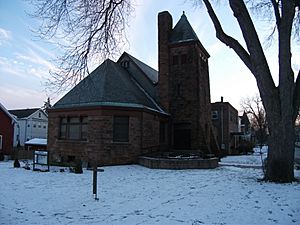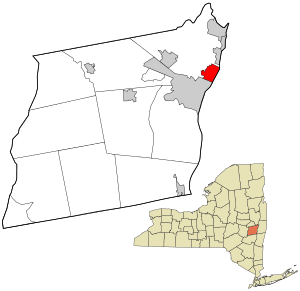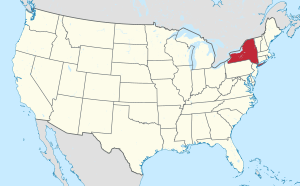Menands, New York facts for kids
Quick facts for kids
Menands
|
|
|---|---|
| Village of Menands | |

Former Bethany Presbyterian Church in Menands, New York
|
|
| Etymology: For Louis Menand, an early landowner | |
| Motto(s):
Urban-Suburban Village
|
|

Location in Albany County and the state of New York.
|
|

Location of New York in the United States
|
|
| Country | United States |
| State | New York |
| County | Albany |
| Settled | 1842 |
| Incorporation as Village | August 14, 1924 |
| Government | |
| Area | |
| • Total | 3.31 sq mi (8.58 km2) |
| • Land | 3.06 sq mi (7.93 km2) |
| • Water | 0.25 sq mi (0.65 km2) |
| Elevation | 36 ft (11 m) |
| Lowest elevation
(sea level)
|
0 ft (0 m) |
| Population
(2020)
|
|
| • Total | 4,554 |
| • Density | 1,487.26/sq mi (574.31/km2) |
| Time zone | UTC−5 (EST) |
| • Summer (DST) | UTC−4 (EDT) |
| ZIP code |
12204
|
| Area code(s) | 518 |
| FIPS code | 36-46536 |
| GNIS feature ID | 0956959 |
| Wikimedia Commons | Menands, New York |
| Website | http://www.villageofmenands.com |
Menands is a small village in Albany County, New York, United States. It's home to about 4,554 people, according to the 2020 census. The village gets its name from Louis Menand, an important person who lived there a long time ago. Menands is located within the larger town of Colonie and is right next to the northern part of Albany.
Contents
Discover Menands: A Village with History
Menands has a rich past, from early explorers to becoming a modern village.
A Look Back in Time
Early Explorers and the Hudson River
Around 1609, the explorer Henry Hudson likely saw the area that is now Menands. He sailed his ship, the Half Moon, up the river that now bears his name. This was as far north as he traveled on the Hudson River. Today, some islands he might have seen are now connected to the mainland.
The Erie Canal's Impact
When the famous Erie Canal was built in the 1820s, it passed right through what would become Menands. Bridges were built over the canal, allowing people to cross easily. These bridges were often named after the local farmers who owned land nearby.
How Menands Became a Village
Louis Menand moved to the area in 1842 and started a big plant-growing business. In 1856, a railroad built a stop near his land and called it "Menand's Crossing." Later, this became "Menand's Station."
In the early 1920s, people heard that the city of Albany might take over the area. To prevent this, the residents voted to become their own official village. On August 23, 1924, Menands was officially formed! At that time, about 1,272 people lived there.
Dutch Village: A Special Community
In 1938, a large housing project called Dutch Village was planned in Menands. It was built on land that had been owned by the Van Rensselaer family since 1639! The buildings were designed with unique steep roofs and brick, looking like early Dutch architecture. This project helped improve local roads and was even called "one of the most interesting housing developments in the East" in 1940.
Printing History and a New Motto
Menands was once home to Williams Press, one of the biggest printing plants in the eastern USA. In the 1940s and 50s, it employed over 1,000 people and printed many popular magazines and phone books.
In 1974, for its 50th anniversary, Menands got its current motto: "Urban-Suburban Village." Local school children from Menands Elementary helped choose the motto and design the village's official seal!
Geography and Location
Menands is located along the western bank of the Hudson River. Most of the village is flat, with a gentle slope rising to the west.
According to the United States Census Bureau, Menands covers about 3.4 square miles (8.8 square kilometers). Most of this is land, with a small part being water.
Village Life and Demographics
Menands has grown quite a bit over the years.
| Historical population | |||
|---|---|---|---|
| Census | Pop. | %± | |
| 1930 | 1,522 | — | |
| 1940 | 1,764 | 15.9% | |
| 1950 | 1,803 | 2.2% | |
| 1960 | 2,314 | 28.3% | |
| 1970 | 3,449 | 49.0% | |
| 1980 | 4,012 | 16.3% | |
| 1990 | 4,333 | 8.0% | |
| 2000 | 3,910 | −9.8% | |
| 2010 | 3,990 | 2.0% | |
| 2020 | 4,554 | 14.1% | |
| U.S. Decennial Census | |||
As of 2000, there were 3,910 people living in Menands. The average age was 43 years old.
Fun and Entertainment in Menands
Menands used to be a very popular spot for fun and games!
Amusement Parks and Sports
Island Parks and Al-Tro Park
In the late 1800s and early 1900s, places like Pleasure Island and Park Island offered lots of entertainment. They had race tracks and other fun activities. In 1907, Al-Tro Island Park opened, boasting a huge boardwalk and an amphitheater that could hold 4,000 people! It was considered one of the best resorts in northern New York.
Baseball at Chadwick Park
Baseball was also a huge draw. Chadwick Park was the home field for the Albany Senators baseball team. In 1931, the famous New York Yankees even played against the Senators there, and Babe Ruth hit two home runs! The stadium later got lights for night games.
Empire Raceways and Shopping
From 1947 to 1963, Empire Raceways was a popular car racing track. Spectators would even sit on the nearby Troy-Menands Bridge to watch the races for free!
Menands was also a shopping hub. Stores like Two Guys, Woolworth, and Montgomery Ward attracted shoppers from all around. The old Montgomery Ward building, built in 1929, was very unique. It had its own railroad track inside for unloading goods! Today, it's an office building called Riverview Center.
Important Places to See
- Albany Rural Cemetery - A part of this large cemetery is located within Menands.
- Troy-Menands Bridge - This bridge crosses the Hudson River, connecting Menands to the city of Troy.
- Riverview Center - This is the former Montgomery Ward store. It's a large Art Deco building that now holds offices and is the tallest building in the town of Colonie.
- Capital District Farmers Market - This market, started in 1933, is one of the biggest in the area.
- Several historic places in Menands are listed on the National Register of Historic Places, including the Albany Felt Company Complex and the Menand Park Historic District.
Village Services
Menands has important services to keep the community safe and running smoothly.
Fire Department
Menands has a volunteer fire department called Menands Fire Co.#1, founded in 1923. They moved into a new fire house in 1983, and their old building became the Menands Police Department and Village Court.
Police Department
The village's first police chief was appointed in 1924, the same year Menands became an official village.
Famous People from Menands
- George Deukmejian (1928-2018) - He was born in Menands and later became the 35th Governor of California.
See also
 In Spanish: Menands (Nueva York) para niños
In Spanish: Menands (Nueva York) para niños



